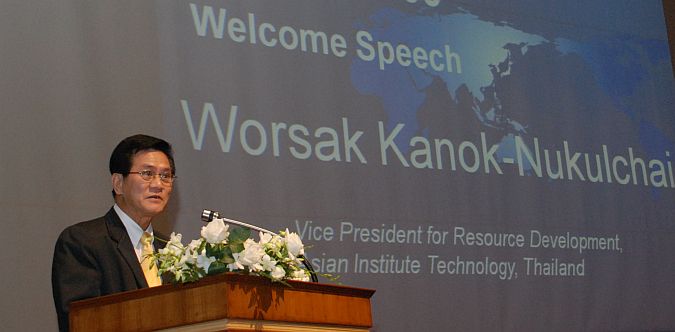He stressed for greater interaction between academia and society and stated that the first step is to establish “a concrete idea of sustainable development”. He provided a concise background of the conference which will last two days.In his welcome speech Prof. Worsak Kanok-Nukulchai, Vice President for Resource Development, AIT, stated that during the last few decades, Asia has witnessed rapid urbanization and industrialization which has in turn led to increased demands on infrastructure. “Unfortunately these demands are not based on sustainability,” Prof. Worsak remarked.Prof. Worsak added that according to AIT’s Strategy 2013, AIT positions itself as a regional knowledge hub which works very closely with the society in Asia. This conference would provide a platform for networking on sustainability issues, he said.
In his keynote speech, Prof. Motoyuki Suzuki of The Open University of Japan, and Special Programme Advisor, provided a global country-by-country picture of sustainability. Pro Suzuki stated that Japan needs to cut its emissions by 84 per cent by 2050 to reach the emissions benchmark. “In the case of Japan, we may need to sacrifice GDP and reduce emissions at the same time,” he remarked.
Dr. Sumet Tantivejkul, Secretary General of the Chaipattana Foundation, stressed the need for a sufficiency economy, based on simplicity, functionality and practicality. He clarified that sufficiency is not subsistence but encompasses a larger concept. Dr.
Sumet also stressed on equitable distribution based on moderation, reasonableness and self immunity.
Dr. Kazuhiko Takeuchi, Deputy Executive Director, Integrated Research System for Sustainability Science, and Vice Rector, United Nations University, Japan, spoke of the need to rebuild the relationship between people and nature. He stated that the earlier relationship between people and nature had collapsed due a number of factors
including the excessive use of fossil fuels.
Elaborating on the traditional Satoyama concept, Dr. Takeuchi said the traditional rural landscape of Japan was the Satoyama landscape. The Satoyama landscape comprises a mosaic of land-uses including agricultural forests and grassland, together with upland fields, rice paddies, hamlets and riparian land. He suggested the need for creation of a “new commons” rather than the traditional commons. We need a human-nature relationship along with human relations and social mechanisms, he added.
Spearheaded by Integrated Research System for Sustainability Science (IR3S) and the University of Tokyo (Todai), the conference is being jointly organized by AIT together with United Nations University (UNU) with the support from Japan Ministry of Education, Culture, Sports, Science and Technology (MEXT) through the Special Coordination Funds
for Promoting Science and Technology.
Watch video: http://www.youtube.com/watch?v=e6eFrYsF9EI

Prof. Worsak Kanok-nukulchai, VicePresident for Resource Development, AIT delivering his welcome speech.

